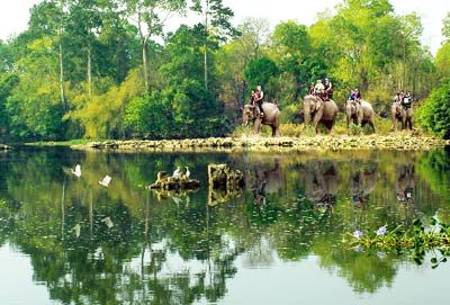VietnamSurprise – Yok Don National Park is located in Ea Bung and Chu M’Lanh communes, Ea Sup district, Krong Na commune, Buon Don district, and Ea Po commune, Cu Jut district, in the western Dak Lak province.
The national park is situated on the flat plain that extends from eastern Cambodia into the northern Dak Lake and southern Gia Lai provinces in Vietnam. The topography of most of the site is flat, at an elevation of c.200 m. There are, however, several ranges of low hills within the national park, the highest point of which is the eponymous Mount Yok Don at 482 m in the southeastern range.
Yok Don National Park is bisected by the Srepok river, one of the major tributaries of the Mekong River. The Srepok river is the only permanent flowing watercourse in the national park: during the dry season, the two largest streams at the site, the Dak Ken and Dak Na, are reduced to a series of interrupted pools. There are also numerous waterholes in the national park, some of which contain water all year.
The vegetation at Yok Don National Park is dominated by a mosaic of deciduous forest and semi-evergreen (mixed deciduous) forest, with smaller areas of evergreen forest, particularly on hills and along watercourses. The deciduous forest is dominated by members of the Dipterocarpaceae family, including Dipterocarpus tuberculatus, D. obtusifolius and Shorea obtusa. However, the Anacardiaceae, Combretaceae, Fabaceae and Myrtaceae families are also well represented. The canopy of this forest type is open, and most trees have thick, fire-resistant bark.
Unlike the deciduous forest, the semi-evergreen forest at the site has a closed canopy, and is stratified into five layers. This forest type is characterized by the presence of Lagerstroemia calyculata, Shorea cochinchinensis and Anisoptera scapula. Evergreen forest has a limited distribution in the national park, being confined to higher elevations on the range of hills in the southeast of the site. This forest type is denser, and is dominated by members of the Fagaceae, Euphorbiaceae, Sapindaceae, Ebenaceae and Meliaceae families.
Because deciduous forest generally supports a lower floral diversity than evergreen forest, the diversity of plant species at Yok Don is lower than that at other national parks in Vietnam. According to Anon (1998), 474 vascular plant species have been recorded at the national park, of which 28 are listed in the Red Data Book of Vietnam. Yok Don is considered to be one of seven internationally important Centers of Plant Diversity in Vietnam.
Yok Don National Park has a reputation as an important site for the conservation of large mammals. Indeed, scientists consider the continued occurrence of Asian Elephant Elephas Maximus, Gaur Bos gaurus, Benton B. javanicus and Tiger Panthera Tigris at Yok Don to be confirmed. However, they report that the populations of all four species at the national park have suffered major declines. In addition, evidence from recent trophies and first-hand reports indicates that the national park may still support small numbers of the globally vulnerable Eld’s Deer Cervus eldii. Furthermore, two globally threatened primate species also occur at the national park: Black-shanked Douc Pygathrix nigripes and Yellow-cheeked Crested Gibbon Hylobates gabriellae.
Several sources list the globally critically endangered Kouprey Bos sauveli as occurring at Yok Don National Park.
A number of globally threatened bird species have been recorded at Yok Don National Park, in particular several large and medium-sized waterbirds, including White-winged Duck Cairina scutulata, Masked Finfoot Heliopais personata and Lesser Adjutant Leptoptilos javanicus. Of particular note, Yok Don is the only site in Vietnam from where there are recent confirmed records of the globally critically endangered Giant Ibis Thaumatibis gigantea. Moreover, Yok Don National Park is one of the few established protected areas in Vietnam to support a significant population of the globally vulnerable Green Peafowl. A recent study estimated that the national park may support around 1,200 individuals. Yok Don National Park contains two Important Bird Areas: Yok Don and Chu M’Lanh.
The Buon Don district is famous as a center for elephant domestication, which is a long tradition among several ethnic groups in this part of the Central Highlands. Elephant riding is now growing in popularity as a tourist attraction, bringing increasing numbers of visitors and revenue to the area. Visitors to Yok Don are able to take elephant rides into the national park.
Source: activetravelvietnam.com

